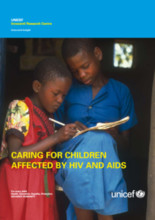By 2003, 15 million children had already lost one or both parents to HIV/AIDS. An additional large group of children live in families or communities where adult illness and death, as well as the stigma surrounding HIV/AIDS, have brought additional hardships. Family coping mechanisms include placing children with relatives, foster families or in residential institutions in the belief that their material needs will be met.
Infants from affected families may be at increased risk of abandonment. In Thailand, for example, the probability of being abandoned by an HIV positive mother was found to be five times that of non- infected mothers in the early stages of the epidemic. HIV is also sometimes used as a justification for removal of children from their parents, with cases of children of HIV positive mothers being taken from their families at birth reported in some countries. There are between two and three million children under 15 years old currently living with HIV/AIDS. Such children are often placed in foster or residential care, because of a real or perceived need for care, or due to abandonment.
Increasing problems in their original families, as well as difficulties encountered in new living arrangements with extended family members or others, may also contribute to children leaving home and migrating on their own, and/or living and working on the street. While such pressures and outcomes are not specific to the impact of HIV on families, the added burden families face, especially in high prevalence areas or where HIV is highly stigmatised, undoubtedly makes this outcome more likely and increasingly common. In Zimbabwe, where the high HIV prevalence means that a majority of orphaned children have lost their parents due to AIDS, an urban-based study found that orphans are over-represented among homeless children by a factor of two.
©International Social Service and UNICEF

